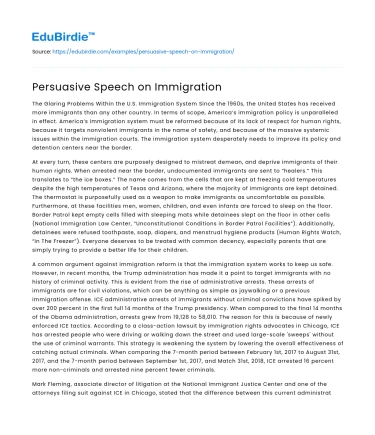The Glaring Problems Within the U.S. Immigration System Since the 1960s, the United States has received more immigrants than any other country. In terms of scope, America’s immigration policy is unparalleled in effect. America’s immigration system must be reformed because of its lack of respect for human rights, because it targets nonviolent immigrants in the name of safety, and because of the massive systemic issues within the immigration courts. The immigration system desperately needs to improve its policy and detention centers near the border.
At every turn, these centers are purposely designed to mistreat demean, and deprive immigrants of their human rights. When arrested near the border, undocumented immigrants are sent to “healers.” This translates to “the ice boxes.” The name comes from the cells that are kept at freezing cold temperatures despite the high temperatures of Texas and Arizona, where the majority of immigrants are kept detained. The thermostat is purposefully used as a weapon to make immigrants as uncomfortable as possible. Furthermore, at these facilities men, women, children, and even infants are forced to sleep on the floor. Border Patrol kept empty cells filled with sleeping mats while detainees slept on the floor in other cells (National Immigration Law Center, “Unconstitutional Conditions in Border Patrol Facilities”). Additionally, detainees were refused toothpaste, soap, diapers, and menstrual hygiene products (Human Rights Watch, “In The Freezer”). Everyone deserves to be treated with common decency, especially parents that are simply trying to provide a better life for their children.
Save your time!
We can take care of your essay
- Proper editing and formatting
- Free revision, title page, and bibliography
- Flexible prices and money-back guarantee
A common argument against immigration reform is that the immigration system works to keep us safe. However, in recent months, the Trump administration has made it a point to target immigrants with no history of criminal activity. This is evident from the rise of administrative arrests. These arrests of immigrants are for civil violations, which can be anything as simple as jaywalking or a previous immigration offense. ICE administrative arrests of immigrants without criminal convictions have spiked by over 200 percent in the first full 14 months of the Trump presidency. When compared to the final 14 months of the Obama administration, arrests grew from 19,128 to 58,010. The reason for this is because of newly enforced ICE tactics. According to a class-action lawsuit by immigration rights advocates in Chicago, ICE has arrested people who were driving or walking down the street and used large-scale 'sweeps' without the use of criminal warrants. This strategy is weakening the system by lowering the overall effectiveness of catching actual criminals. When comparing the 7-month period between February 1st, 2017 to August 31st, 2017, and the 7-month period between September 1st, 2017, and Match 31st, 2018, ICE arrested 16 percent more non-criminals and arrested nine percent fewer criminals.
Mark Fleming, associate director of litigation at the National Immigrant Justice Center and one of the attorneys filing suit against ICE in Chicago, stated that the difference between this current administration and the last is that 'they are literally doing roving stops, whether by car or on foot, stopping people without any sort of articulable fact. It sends a message to the Hispanic community that we intend to racially profile you in your communities.' This, understandably, creates a bad relationship between the Hispanic community and members of authorities such as ICE agents and police chiefs. This makes Hispanic and especially immigrant communities afraid of talking to police and less likely to report crimes or cooperate with local investigations. Therefore, the immigration system is simultaneously decreasing its own effectiveness against criminals and decreasing the rate at which other immigrants are willing to cooperate with local, state, and federal officers. The immigration courts themselves present further issues. The courts are backlogged, they are in need of lawyers, and in need of judges.
Over the past decade, Congress has increased the funding for immigration at an exponential rate, while it has not provided the immigration courts with the proper funding to handle the hundreds of additional removal cases. Customs and Border Protection (CBP) and ICE combined spending per year increased 105 percent from 2003 to 2015. The yearly budget grew from $9.1 billion to approximately $18.7 billion. To contrast, immigration court spending increased at a rate of 74 percent over the same time period. This is despite the fact that the court budget is a fiftieth of the enforcement budget. This relatively low budget is not enough to sustain an efficient court system. The low budget results in fewer staff and judges. Between 2011 and 2016, the number of federal judges decreased by almost 14 percent. In 2014, an immigration judge handled 1,400 “matters” per year while federal judges had 570 cases per year in 2011. As a result, fewer judges and more cases have led to a growth in the immigration court system backlog. In 2014, courts received 23 percent more matters than they completed and as more cases are filed than can be completed, the amount of cases awaiting trial accumulates. The backlog is not only a testament to the immigration system’s lack of efficiency but it also negatively affects legal immigrants. U.S. citizens who legally petition for siblings to receive immigrant visas and legally migrate are met by the backlog.






 Stuck on your essay?
Stuck on your essay?

